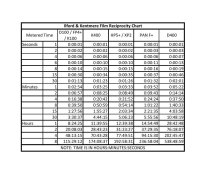Neil Kelly
Member
Hi all,
I'll be going away for a long weekend to Oslo this coming weekend, and I'd like to try and do some long exposures of the city/water/sky etc. I've not done this before so I'm trying to wrap my head around the calculations and where reciprocity failure comes into things
If for example, I have a metered exposure time of say 1/10th second, and I want to use a 6 stop ND filter (ND64) - giving an exposure time of 6.4 seconds according to this page - http://www.vassilistangoulis.com/gr/?p=4958
Do I then count this extended time as the psuedo metered time for calculating reciprocity failure correction?
In this example, if I were using Ilford Delta 100, this would then give a corrected exposure time of 10.4 seconds (per the document on the Ilford website here (https://www.ilfordphoto.com/wp/wp-content/uploads/2017/06/Reciprocity-Failure-Compensation.pdf)
Does this workflow and method of working make sense? I can find information on reciprocity failure corrections and on using ND filters separately but I can't seem to find much on both together (if I'm being a bit simple, I apologise!)
I know this might seem very simple, but I just wanted to double check with the gurus here before I go off and make a fool of myself (and waste film!)
All replies and advice greatly appreciated
I'll be going away for a long weekend to Oslo this coming weekend, and I'd like to try and do some long exposures of the city/water/sky etc. I've not done this before so I'm trying to wrap my head around the calculations and where reciprocity failure comes into things
If for example, I have a metered exposure time of say 1/10th second, and I want to use a 6 stop ND filter (ND64) - giving an exposure time of 6.4 seconds according to this page - http://www.vassilistangoulis.com/gr/?p=4958
Do I then count this extended time as the psuedo metered time for calculating reciprocity failure correction?
In this example, if I were using Ilford Delta 100, this would then give a corrected exposure time of 10.4 seconds (per the document on the Ilford website here (https://www.ilfordphoto.com/wp/wp-content/uploads/2017/06/Reciprocity-Failure-Compensation.pdf)
Does this workflow and method of working make sense? I can find information on reciprocity failure corrections and on using ND filters separately but I can't seem to find much on both together (if I'm being a bit simple, I apologise!)
I know this might seem very simple, but I just wanted to double check with the gurus here before I go off and make a fool of myself (and waste film!)
All replies and advice greatly appreciated







